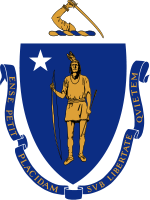- Seal of Massachusetts
-
The Great Seal of the Commonwealth of Massachusetts contains the coat of arms of Massachusetts. The coat of arms is encircled by the Latin text "Sigillum Reipublicæ Massachusettensis" (literally, The Seal of the Republic of Massachusetts). The Massachusetts Constitution nevertheless designates the name of the government as Commonwealth, not Republic. The Seal uses as its central element, the Coat of Arms of Massachusetts. An official emblem of the State, the Coat of Arms was adopted by the Legislature in 1775, and then reaffirmed by Governor John Hancock and his Council on December 13, 1780. The present rendition of the seal was drawn by resident-artist Edmund H. Garrett, and was adopted by the state in 1900.[1]
Contents
History
The seal was adopted by the Provincial Congress on December 13, 1780. The shield depicts an Algonquian Native American with bow and arrow; the arrow is pointed downward, signifying peace. A white star with five points appears next to the figure's head. A blue ribbon (blue, signifying the Blue Hills of Quincy, Canton and Milton) surrounds the shield, bearing the state motto "Ense petit placidam sub libertate quietem" This comes from the Book of Mottoes in the Royal Danish Library in Copenhagen, Denmark; written about 1659 by Algernon Sydney, English soldier and politician. It was adopted in 1775 by the Provincial Congress and means, "With a sword, she seeks quiet peace under liberty." Above the shield is the state military crest: a bent arm holding a broadsword aloft. The sword has its blade up, to remind that it was through the American Revolution that independence was won.
There have been a number of Seals of Massachusetts throughout history. The first seal of Massachusetts Bay Colony showed a nude American Indian with a bush covering his groin. Like the current seal, he held in his hand an arrow pointed down. A scroll came out over his mouth with the words "Come over and help us," emphasizing the missionary and commercial intentions of the original colonists. This legend coming from the Indian's mouth may originate with Acts 16:9 "And a vision appeared to Paul in the night; There stood a man of Macedonia, and prayed him, saying, Come over into Macedonia, and help us." (Authorized Version)[citation needed]. This seal was used until 1686, shortly after the charter was annulled, and again from 1689-1692.
For the first time the Latin phrase appeared on a state seal and meant that the colony no longer recognized the authority of the Royal Governor General Thomas Gage. The source is attributed to the letter written by a father of an English soldier and politician Algernon Sidney: "It is said that the University of Copenhagen brought their album unto you, desiring you to write something therein; and that you did scribere in albo these words: 'Manus haec inimica tyrannis ense petit placidam sub libertate quietem'". (Translated, this means "This hand of mine, which is hostile to tyrants, seeks by the sword quiet peace under liberty.") The last words were then written in Sidney's "Book of Mottoes", particularly favored by some in the American colonies. Metrically, the motto is dactylic hexameter.
A stained glass window at the top of the Grand Stair Case at the State House shows all the seals used in Massachusetts, including the royal seals of the Governors during colonial days.
Government Seals of Massachusetts
-
Seal of the Governor of Massachusetts
-
Seal of the Massachusetts Senate
-
Seal of the Massachusetts State Police
See also
- Coat of Arms of the U.S. States
- Seals of the U.S. states
- List of Massachusetts state symbols
- Flag of Massachusetts
References
- ^ Garrett, E. H. (1901). "The Coat of Arms and Great Seal of Massachusetts". The New England Magazine (Boston: Warren F. Kellogg) XXIII (6): 623–635.
External links
 Commonwealth of Massachusetts
Commonwealth of MassachusettsTopics Index · Administrative divisions · Congressional districts · Culture · Demographics · Economy · Education · Elections · Geography · Geology · Government · History · Images · Music · People · Politics · Sports · State symbols · Transportation · Villages · Visitor Attractions · Windmills
Regions The Berkshires · Blackstone Valley · Cape Ann · Cape Cod · Central Massachusetts · Greater Boston · The Islands · Merrimack Valley · MetroWest · Montachusett-North County · North Shore · Pioneer Valley · Quabbin Valley · Southeastern Massachusetts · South Coast · South County · South Shore · Western Massachusetts
Counties Cities
(see all
municipalities)Agawam · Amesbury · Attleboro · Barnstable · Beverly · Boston · Braintree · Bridgewater · Brockton · Cambridge · Chelsea · Chicopee · Easthampton · Everett · Fall River · Fitchburg · Franklin · Gardner · Gloucester · Greenfield · Haverhill · Holyoke · Lawrence · Leominster · Lowell · Lynn · Malden · Marlborough · Medford · Melrose · Methuen · New Bedford · Newburyport · Newton · North Adams · Northampton · Palmer · Peabody · Pittsfield · Quincy · Randolph · Revere · Salem · Somerville · Southbridge · Springfield · Taunton · Waltham · Watertown · Westfield · West Springfield · Weymouth · Winthrop · Woburn · Worcester
Note: Municipalities not listed above have a town meeting form of government. Municipalities listed above in italics have a city form of government, but have retained the name prefix "Town of " as part of their official names.Categories:- United States state seals
- Symbols of Massachusetts
-
Wikimedia Foundation. 2010.






